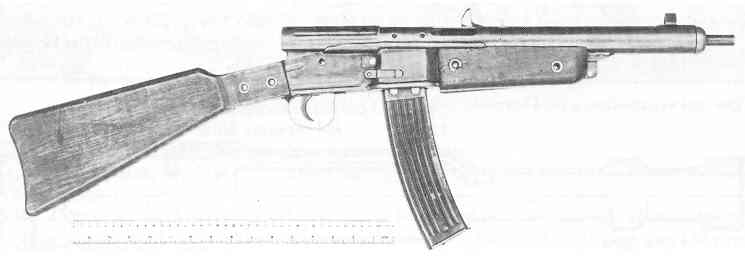MKb 42(H)
The original Haenel produced prototype weapons incorporated many of the features of earlier Schmeisser designs, such as the MP38 and MP40 submachineguns. The prototypes featured a simple gas operation system with the gas tube and pistol positioned above the barrel.
[CENTER][/CENTER]
The rifle used a striker firing mechanism and was fired from an open bolt and used a tilting block locking mechanism.

The gas piston extension, when forced rearward by the expanding propellant gases, would lift the bolt out of its locked position, and carry it to the rear for the extraction and ejection cycles, and then, under pressure from the operating spring, pull the bolt forward, strip a fresh round into the chamber, and force the bolt downward into its locking recess in the receiver. The cocking handle was placed on the left side of the receiver so as to enable the operator to recharge the rifle with the left hand while not disturbing aiming. The 30 round detachable box magazine was intended to serve as a firing support in the prone position.
[CENTER][/CENTER]
The receiver was entirely enclosed in the rifle’s sheet metal main group housing, and was secured by means of locating pins and indentation into which the sheet metal was pressed. Disassembly of the receiver from the housing was not contemplated, and required the destruction of the weapon to achieve.
The fire control group was contained in a stamped sheet metal housing hinged to the bottom of the receiver, which also served as the trigger guard and pistol grip. A cross-bolt type of selector was used for semiautomatic and automatic firing modes. When the bolt was pushed to the left, the letter D (for Dauerfeuer or full auto firing) was exposed. When pushed to the right, the letter E (for Einzelfeuer, or single shot firing) was exposed. The safety system on the prototypes was an L-shaped notch in the rear of the cocking handle slot and a forward cut out, thus permitting the bolt to be held in the rear safe or forward locked positions.
Barrel length was about fifteen inches ending in a threaded muzzle with a protective muzzle nut. Handguards were of formed sheet metal held in place by a friction fit.
Based on experiences with the Mkb 42 (H) prototypes, the Heereswaffenamt mandated various changes to the design. These included provisions for mounting the standard service bayonet, as well as increasing the diameter and pitch of the muzzle threads. By November 1942, deliveries of the new MKb were reaching troops in significant numbers. Initial reports from the field were very favorable, with the only negative comments being the high prone firing position necessitated by the long magazine and the brilliant muzzle flash during night firing. Modifications to the MKb 42(H) also included a spring loaded ejection port cover (much like that found on M16 rifles) to keep debris out of the mechanism, and telescope mounting rails on the rear sight block. A total of 11,853 Mkb 42(H)'s were produced between November 1942 and September 1943 when MKb production gave way to the improved MP43 series.
http://www.cruffler.com/historic-february00.html




